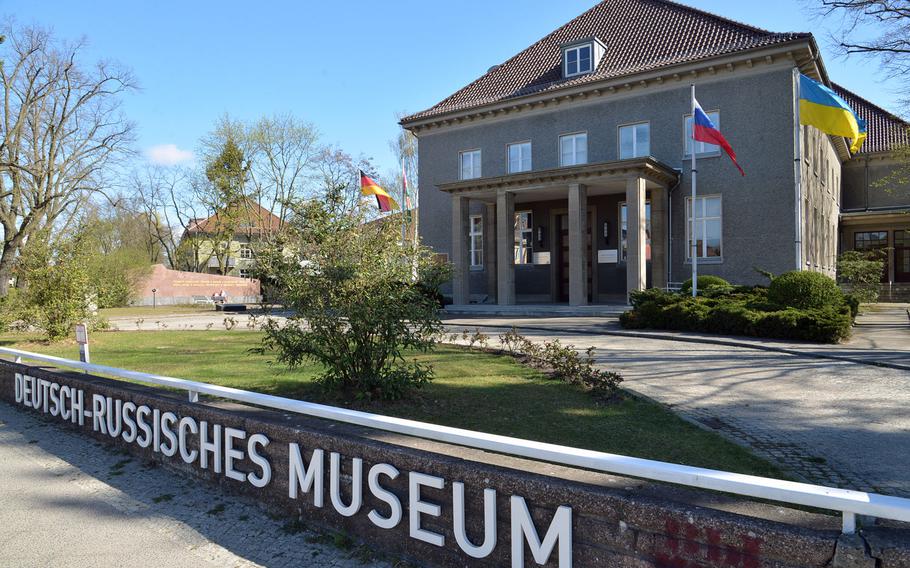
The German-Russian Museum in Berlin-Karlshorst. The building, a former German officers' mess, was Red Army headquarters during the battle for Berlin when the surrender was signed. From 1945 to 1949 it was the headquarters of the Soviet Military Administration in Germany. In 1967 the Red Army opened the "Museum of Unconditional Surrender of Fascist Germany in the Great Patriotic War of 1941-45." The current museum opened in 1995. (Michael Abrams/Stars and Stripes)
The German-Russian Museum is housed in the historic building in Berlin-Karlshorst where, shortly after midnight May 9, 1945, the Nazis signed the surrender document ending World War II in Europe.
In 1967, the Red Army opened there the aptly — but typically Soviet — named “Museum of Unconditional Surrender of Fascist Germany in the Great Patriotic War of 1941-45.”
The building, a former German officers’ mess, was Red Army headquarters during the battle for Berlin. From 1945 to 1949, it served as the headquarters of the Soviet Military Administration in Germany.
With the end of the Cold War, the reunification of Germany and the withdrawal of Russian troops from the country, the military gave up the museum in 1994.
The German and Russian governments agreed to support the museum and keep it at this significant location. With a reworked theme and content, the German-Russian Museum opened in 1995.
The focal point of the museum is, of course, the ground-floor room where Nazi Field Marshal Wilhelm Keitel signed Germany’s unconditional capitulation.
It is a large wood-floored room with ceiling-high windows. The flags of the United States, France, the Soviet Union and Great Britain hang over the table where the document was signed. Facsimiles of the document in German, English and Russian are also on display. A screen hanging from the ceiling shows a video of the signing.
Also on the ground floor is Marshal Georgy Zhukov’s office with a bust of him and his uniform on display. Also worth seeing is a large diorama depicting the Red Army’s attack on the Reichstag in Berlin on April 30, 1945.
The rest of the permanent display is upstairs and in the basement. Titled “Germany and the Soviet Union in World War II 1941 to 1945,” it traces the countries’ relations. Some of topics are the Soviet Union at war, Soviet prisoners of war, the anti-Hitler coalition, German POWs and the consequences of the war. One room is a timeline of the war from the Nazi invasion of the Soviet Union in 1941 to their defeat in 1945.
It is a modern and personal exhibit. Audio and video presentations go along with photos, posters and artifacts on display. Visitors can listen to soldiers, civilians, resistance fighters and former prisoners tell their story in Russian, German or English. Biographies of movers and shakers of the war — both military and political — are displayed in drawers that pull out of the display cases.
Interesting contrasts are shown, too. In one small section the photography of war is covered, featuring a Soviet photo correspondent, Timofey Melnik, and a German soldier, Wilhelm Meyer, who took snapshots of his experience at the front. Both used German-made Leica cameras. Photos from both can be found throughout the museum.
Soviet patriotic posters are on display as well as an American one. With a picture of a Russian soldier, it proclaims that “This man is your friend; He fights for freedom.” A giant poster covering a wall depicts Hitler being strangled by the Allies, the Americans and British from the west and the Soviets from the east.
The Holocaust and life under German occupation are well covered in the exhibit. Outside, Soviet tanks and artillery are on display behind the museum, while to its left is a monument featuring a T-34 tank. The inscription on the wall behind it, translated, reads: “The heroic deeds of the Soviet soldiers who fought against fascism will live forever in the hearts of present and future generations.”
The German-Russian Museum, Berlin Karlshorst
DIRECTIONS The German-Russian Museum is in the Karlshorst district of Berlin at Zwieseler Strasse 4, 10318 Berlin. There is parking nearby.
On public transportation, take the S3 train to the Karlshorst station, exit at Treskowallee, then walk down Rheinsteinstrasse, which ends at the museum (about 15 minutes) or take bus 296 from the start of Rheinsteinstrasse to the museum.
Alternatively, take U5 to the Tierpark station and then bus 296 to the museum.
TIMES The museum is open Tuesday to Sunday from 10 a.m. to 6 p.m.
COSTS Admission is free, but a donation is welcome. Renting an audio guide costs 3 euros with a 10-euro deposit. The museum catalog costs 8 euros and is worth it.
INFORMATION The museum’s web site is www.museum-karlshorst.de.